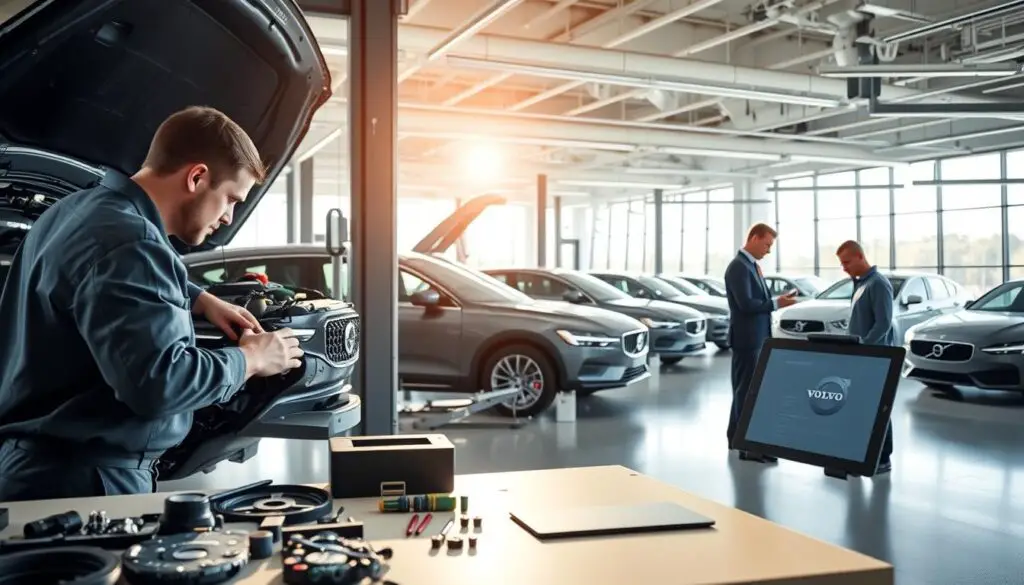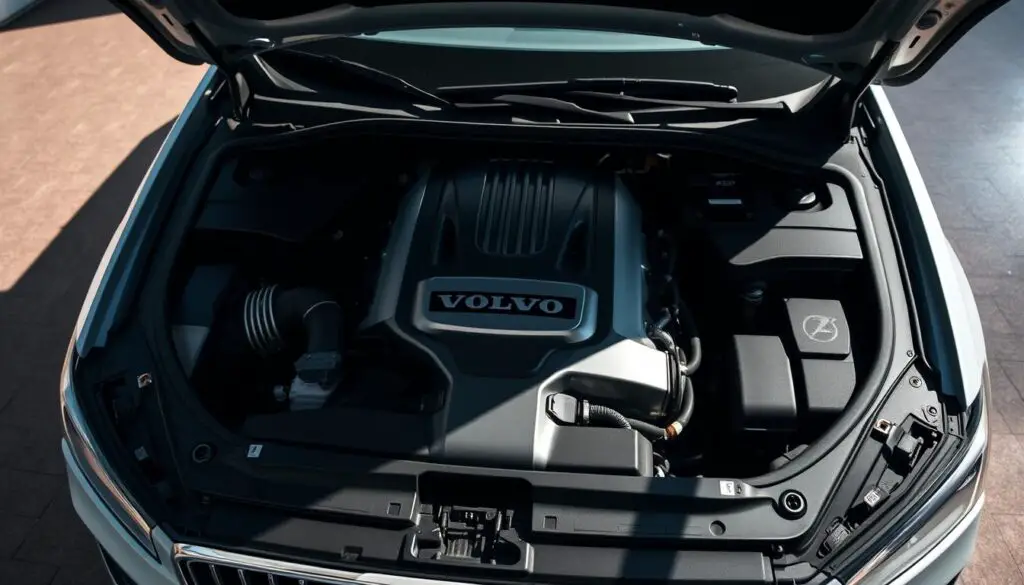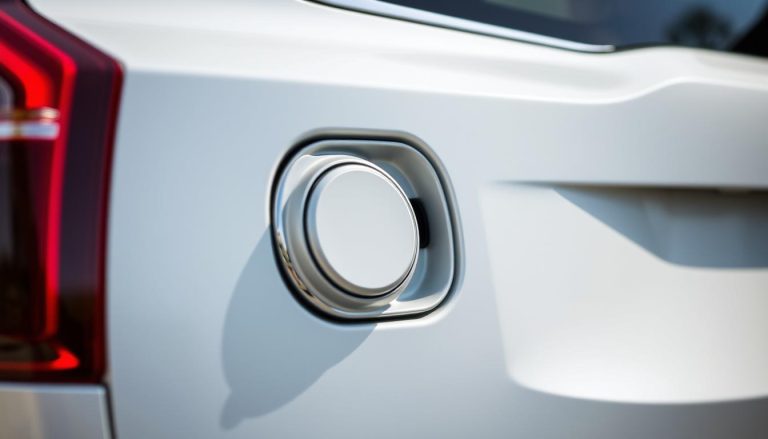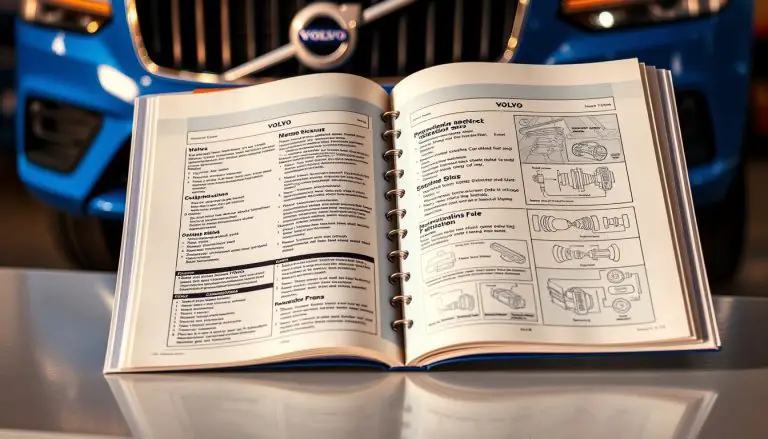Regular maintenance is crucial for extending the lifespan of your Volvo vehicles and preventing costly repairs down the line. By following the tips and best practices outlined in this article, owners can ensure their automobiles continue to run smoothly and efficiently.
For Volvo cars, recommended servicing is typically every 10,000 miles or once a year, whichever comes first. However, certain factors such as driving habits and environmental conditions may necessitate more frequent servicing. It’s recommended to have your vehicle serviced at an authorized dealership for the highest quality service and genuine parts, as discussed in our detailed guide on Volvo maintenance FAQs.
Key Takeaways
- Regular maintenance checks include oil changes, filter replacements, and tire rotations.
- The vehicle is equipped with a maintenance reminder system.
- Driving habits and environmental conditions affect servicing frequency.
- Authorized dealerships provide the highest quality service.
- Genuine Volvo parts ensure optimal performance.
Understanding Your Volvo Car’s Maintenance Needs
The key to a well-maintained Volvo lies in understanding its specific maintenance requirements. Whether you own a Volvo sedan, a Volvo SUV, or a Volvo electric car, regular maintenance is crucial for longevity and performance.
Importance of Regular Maintenance
Regular maintenance is essential for preventing wear and tear, improving fuel efficiency, and ensuring safety on the road. For Volvo sedans and Volvo SUVs, this includes routine checks on tire pressure, oil levels, and brake pads. Volvo electric cars also require regular checks, although their maintenance needs differ slightly, focusing more on battery health and electrical system checks.
Common Maintenance Checklist
A common maintenance checklist for Volvo cars includes:
- Oil changes
- Tire rotations
- Brake pad replacements
- Battery checks
- Fluid level checks (engine oil, coolant, brake fluid)
For Volvo electric cars, the checklist might include additional items such as:
- Battery health checks
- Electrical system diagnostics
Understanding the Owner’s Manual
The owner’s manual provides a detailed schedule and guidelines for maintenance, which should be followed closely to ensure the longevity of your Volvo. It outlines the recommended service intervals, maintenance tasks, and troubleshooting tips specific to your Volvo model.
| Maintenance Task | Interval | Notes |
|---|---|---|
| Oil Change | Every 5,000 to 7,500 miles | Check owner’s manual for specific interval |
| Tire Rotation | Every 6,000 to 8,000 miles | Improves tire life and fuel efficiency |
| Brake Pad Replacement | Every 30,000 to 50,000 miles | Check for wear and tear regularly |
By understanding and adhering to these maintenance needs, Volvo owners can ensure their vehicles remain in optimal condition, providing a safe, efficient, and enjoyable driving experience.
Scheduled Maintenance Services for Volvo Cars
To ensure your Volvo car remains in top condition, understanding scheduled maintenance services is crucial. Regular maintenance not only prolongs the life of your vehicle but also ensures it runs efficiently and safely.

Service Intervals Explained
Service intervals for Volvo luxury vehicles and Volvo hybrid models are typically outlined in the owner’s manual. These intervals can vary based on the model year, driving conditions, and other factors. It’s essential to familiarize yourself with these intervals to keep your Volvo in optimal condition.
For instance, some Volvo models may require more frequent oil changes or tire rotations depending on whether you’ve driven in harsh conditions or have accumulated high mileage.
Types of Scheduled Services
Scheduled maintenance for Volvo cars includes a variety of services designed to keep your vehicle running smoothly. These services may include:
- Oil changes to keep the engine lubricated
- Tire rotations to ensure even wear
- Brake inspections to identify wear or potential issues
- Fluid checks to maintain the health of various vehicle systems
By adhering to these scheduled services, you can prevent minor issues from becoming major problems.
Importance of Following the Maintenance Schedule
Following the recommended maintenance schedule is crucial for the longevity and performance of your Volvo. Neglecting scheduled maintenance can lead to decreased fuel efficiency, reduced vehicle performance, and potentially costly repairs down the line.
“Regular maintenance is key to maintaining the safety and performance of your vehicle. It’s not just about following a schedule; it’s about ensuring your Volvo continues to provide you with a safe and enjoyable driving experience.” –
By staying on top of scheduled maintenance, you can enjoy your Volvo luxury vehicle or Volvo hybrid model for years to come, knowing that it’s well-maintained and running at its best.
Engine Maintenance and Care for Volvo Vehicles
The engine is the heart of your Volvo, and proper maintenance is essential to keep it running smoothly. Regular maintenance not only ensures the longevity of your vehicle but also maintains its performance and fuel efficiency.
Oil Change Recommendations
One of the most critical aspects of engine maintenance for your Volvo vehicle is regular oil changes. Engine oil lubricates the moving parts, reduces friction, and prevents wear and tear. It’s recommended to check your owner’s manual for the specified oil change interval, as it may vary depending on the model and year of your Volvo automobile. Typically, Volvo suggests oil changes between 5,000 to 7,500 miles.
Using the correct type of oil is also crucial. For most Volvo sedans, synthetic oil is recommended due to its superior lubricating properties and performance in extreme temperatures.
Importance of Engine Diagnostics
Engine diagnostics play a vital role in identifying potential issues before they become major problems. Modern Volvos are equipped with advanced diagnostic systems that can detect faults and alert the driver through dashboard warning lights. Regular diagnostic checks can help in early detection of issues such as faulty sensors, fuel system problems, or ignition system malfunctions.
Tips for Maintaining Engine Performance
To keep your Volvo’s engine performing at its best, several maintenance tasks should be regularly performed. First, ensure that your oil levels are always at the recommended level. Second, check for signs of leaks around the engine, as leaks can lead to significant damage if not addressed promptly.
Another crucial task is maintaining a clean air filter. A dirty air filter can lead to decreased engine performance and fuel efficiency. Replacing the air filter at the recommended intervals can help in maintaining optimal engine performance.

Tires: Maintenance and Replacement for Volvo Cars
For Volvo car owners, tire maintenance is not just about safety; it’s also about optimizing vehicle performance. Proper tire care can significantly impact the overall driving experience, fuel efficiency, and longevity of the vehicle.
Tire Rotation and Alignment
Regular tire rotations and alignments are crucial for preventing uneven wear and tear on your Volvo’s tires. It is recommended to rotate tires every 5,000 to 8,000 miles. Proper alignment not only ensures even tire wear but also improves handling and fuel efficiency. For Volvo SUVs and other models, following the manufacturer’s guidelines for tire rotation and alignment is key.
- Rotate tires every 5,000 to 8,000 miles.
- Check tire pressure monthly and before long trips.
- Inspect tires for signs of uneven wear or damage.
Recognizing When to Replace Tires
Tires should be replaced when they show signs of significant wear, such as tread depth below 2/32″, uneven wear patterns, or damage from road hazards. Regular inspections can help identify these issues early. For Volvo electric cars, maintaining the right tire condition is vital for maximizing range and efficiency.
Recommended Tire Types for Volvo
Volvo recommends specific tire types for their vehicles, which vary by model and year. For Volvo luxury vehicles, high-performance tires that balance comfort, handling, and durability are typically recommended. It’s essential to consult your owner’s manual or speak with a Volvo dealership to determine the best tire type for your specific vehicle.
Brake System Maintenance in Your Volvo
The brake system is a vital component of your Volvo, requiring regular maintenance to function effectively. A well-maintained brake system is crucial for the safety and performance of your vehicle, whether it’s a standard model or one of the innovative Volvo hybrid models.
Signs of Brake Wear
Identifying signs of brake wear early can prevent more severe problems. Common indicators include squealing or grinding noises when applying the brakes, a spongy brake pedal, or vibrations felt when braking. If you notice any of these symptoms in your Volvo cars, it’s essential to have your brake system inspected.
Importance of Brake Fluid Checks
Regular brake fluid checks are vital for the proper functioning of your Volvo’s brake system. Brake fluid plays a crucial role in transferring pressure to the brakes, and low levels or contaminated fluid can lead to brake failure. Ensuring your Volvo vehicles have the correct brake fluid level is a simple yet critical maintenance task.
Recommended Brake Pads and Rotors
Using the recommended brake pads and rotors for your Volvo is essential for maintaining the effectiveness of the brakes. Genuine Volvo parts or equivalent high-quality aftermarket parts should be used to ensure compatibility and performance. This not only enhances safety but also helps in preventing costly repairs down the line.
By staying on top of brake system maintenance, Volvo owners can enjoy a safer driving experience. Regular inspections and the use of appropriate parts are key to maintaining the high standards of safety and performance expected from Volvo vehicles.
Electrical System Maintenance for Volvo Cars
Maintaining the electrical system in your Volvo is crucial for optimal performance and longevity. The electrical system is a complex network that powers various components, including the engine, lights, and accessories.
Understanding Vehicle Battery Lifespan
The battery is a critical component of your Volvo’s electrical system. Typically, a car battery lasts between three to five years, depending on factors such as driving habits, climate, and maintenance. Regular battery checks can help identify potential issues before they become major problems.
To maximize the lifespan of your Volvo’s battery, avoid frequent short trips, ensure that all electrical components are turned off when not in use, and have your battery tested regularly.
Tips for Maintaining Electrical Components
Maintaining the electrical components in your Volvo involves several key practices. First, ensure that all connections are clean and free of corrosion. Regularly inspect the condition of your vehicle’s wiring and replace any damaged or worn-out components.
- Check the battery terminals for corrosion and clean them as needed.
- Inspect the alternator belt for signs of wear and replace it if necessary.
- Test the electrical system regularly to identify any potential issues early.
Signs of Electrical System Problems
Being aware of the signs of electrical system problems can help you address issues promptly. Common indicators include dim or flickering lights, difficulty starting the engine, or malfunctioning accessories.
| Symptom | Possible Cause | Recommended Action |
|---|---|---|
| Dim or Flickering Lights | Low battery voltage or faulty alternator | Have the battery and alternator tested |
| Difficulty Starting the Engine | Weak battery or faulty starter motor | Check the battery condition and starter motor |
| Malfunctioning Accessories | Faulty wiring or blown fuse | Inspect the wiring and replace the fuse if necessary |
By understanding the importance of electrical system maintenance and recognizing the signs of potential problems, you can help ensure that your Volvo automobile, whether it’s a sedan or SUV, continues to operate reliably and efficiently.
Choosing Professional Service vs. DIY Maintenance
Maintaining your Volvo, whether it’s a Volvo electric car, a Volvo luxury vehicle, or a Volvo hybrid model, requires careful consideration of whether to opt for professional service or DIY maintenance. Professional maintenance offers the advantage of experienced technicians and specialized equipment, ensuring that complex tasks are handled efficiently.
Expertise and Equipment
Professional service centers have the necessary expertise and equipment to handle a wide range of maintenance tasks, from routine oil changes to complex repairs on advanced Volvo models.
DIY Maintenance Considerations
On the other hand, DIY maintenance can be cost-effective and educational for Volvo owners who are comfortable with performing repairs themselves. Resources such as the owner’s manual, online forums, and repair manuals are available to guide DIY maintenance.
Ultimately, the decision between professional service and DIY maintenance depends on your comfort level, the complexity of the task, and the resources available. For owners of Volvo electric cars and Volvo hybrid models, it’s often recommended to rely on professional service for tasks that involve complex electrical systems.
FAQ
How often should I perform routine maintenance on my Volvo car?
The frequency of routine maintenance for your Volvo car depends on the model, year, and mileage. It’s best to consult your owner’s manual for a detailed maintenance schedule, but generally, oil changes are recommended every 5,000 to 7,500 miles, and tire rotations every 6,000 to 8,000 miles.
What are the benefits of using genuine Volvo parts for maintenance and repairs?
Genuine Volvo parts are designed to meet the manufacturer’s specifications, ensuring optimal performance, safety, and durability. Using genuine parts can also help maintain your vehicle’s warranty and resale value.
Can I perform DIY maintenance on my Volvo SUV or should I visit a dealership?
While some maintenance tasks, such as oil changes and tire rotations, can be performed DIY, more complex tasks, like brake system maintenance, may require professional expertise. If you’re unsure, it’s always best to consult your owner’s manual or visit a certified Volvo dealership for guidance.
How do I know when my Volvo needs a tire replacement?
Check your tire tread depth regularly, and look for signs of uneven wear. If your tread is worn down to 2/32″ or less, it’s time to replace your tires. You can also consult your owner’s manual for specific guidelines on tire replacement for your Volvo model.
What are the recommended maintenance tasks for my Volvo electric car?
While electric cars require less maintenance than traditional gas-powered vehicles, it’s still essential to follow a regular maintenance schedule, including tasks like tire rotations, brake pad replacements, and software updates. Consult your owner’s manual for specific guidance on maintaining your Volvo electric car.
How can I extend the lifespan of my Volvo’s battery?
To extend the lifespan of your Volvo’s battery, avoid extreme temperatures, keep the battery terminals clean, and avoid deep discharging. Regular maintenance checks can also help identify potential issues before they become major problems.
What are the signs of brake wear in my Volvo car?
Signs of brake wear in your Volvo car include squealing or grinding noises, spongy brake pedals, or vibrations when braking. If you notice any of these symptoms, have your brake system inspected by a certified technician as soon as possible.
Can I use aftermarket parts for my Volvo’s maintenance and repairs?
While aftermarket parts may be cheaper, they may not meet the manufacturer’s specifications, potentially compromising your vehicle’s performance, safety, and warranty. It’s generally recommended to use genuine Volvo parts for maintenance and repairs.


